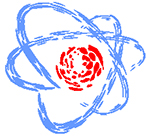Speaker
Mr
Yury Stepanenko
(JINR)
Description
The E391 experiment (KEK, Japan) was the first dedicated experiment in the world devoted to the definition of the upper limit of Br (K0L → π0νν), which can be considered as ideal process for measurement the effect of CP violation in the Standard Model. K0L → π0νν decay is characterized by a low value of the branching ratio, which in SM predictions equals to 2.8x10-11. Therefore the most important task of the E391 experiment was to achieve the maximum sensitivity of the detector to the decay registration.
We developed two new methods for E391 experiment data analysis: 1) method of angle measurement of gamma-quanta registered by the CsI-calorimeter with using neural network, 2) automatic cut optimization technique based on the application of genetic algorithms. Usage of these methods in analysis provides deeper suppression of the background sources and selection of the signal events - candidates of the searched K0L→π0νν decay. This allows obtaining a significant increase in the efficiency of registration of decay in the experiment. The results of reprocessing the data of the E391experiment using the developed methods are presented.
Primary author
Mr
Yury Stepanenko
(JINR)

